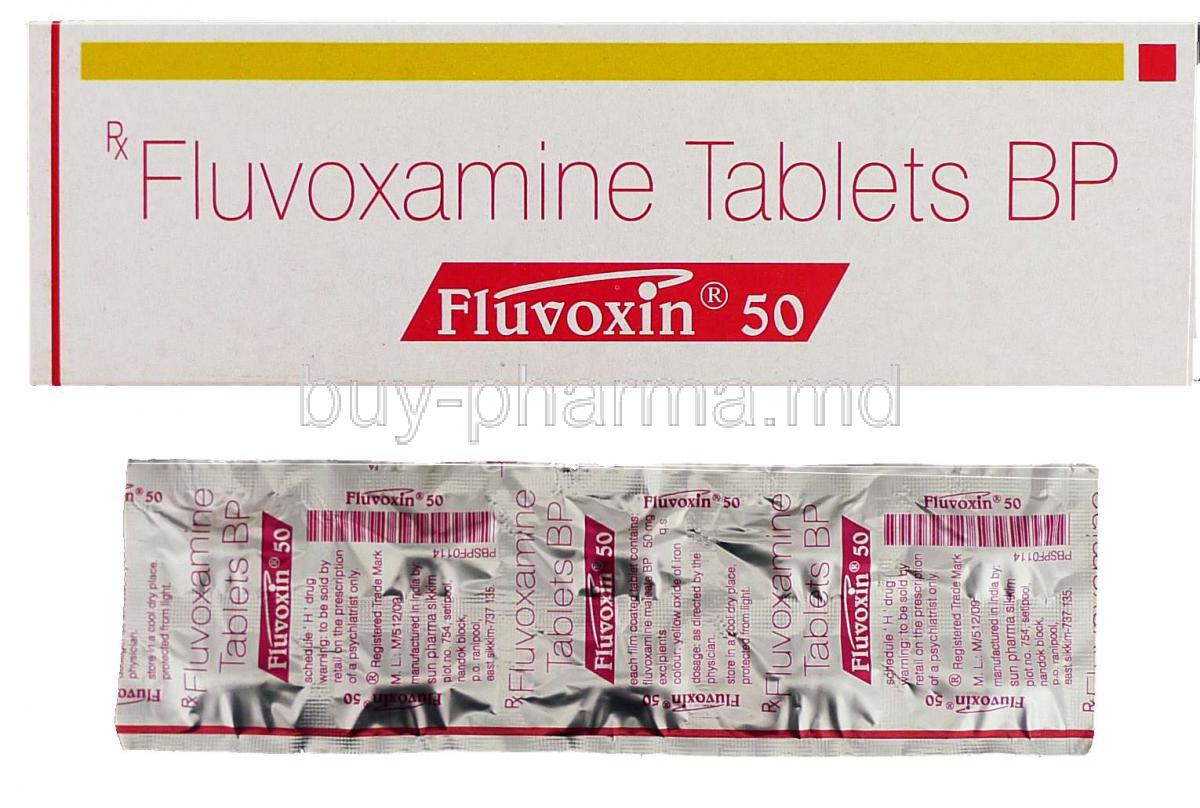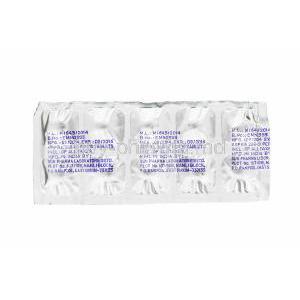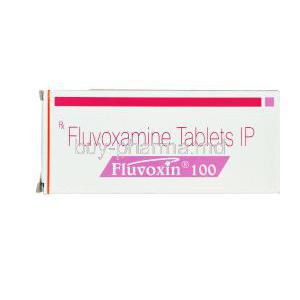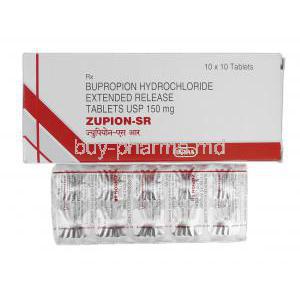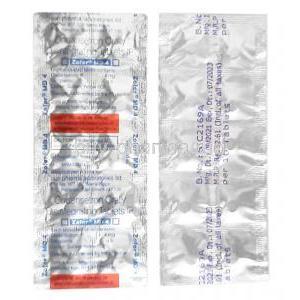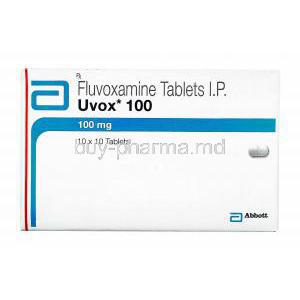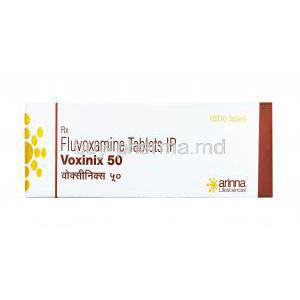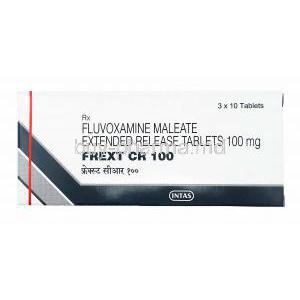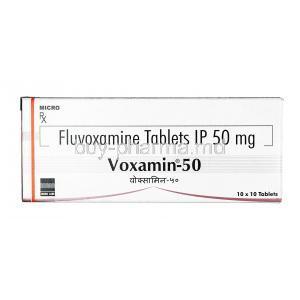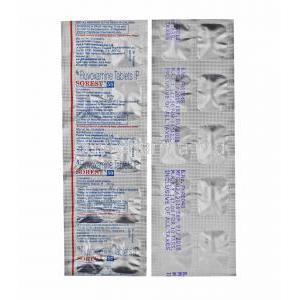Introduction
Fluvoxin, containing the active compound Fluvoxamine Maleate, is a renowned antidepressant classified as a Selective Serotonin Reuptake Inhibitor (SSRI). It is primarily indicated for the management of depressive and anxiety-related disorders, offering therapeutic relief through precise modulation of brain chemistry. Initially developed in the late 20th century, fluvoxamine received global recognition following its approval for treating obsessive-compulsive disorder (OCD) and major depressive disorder (MDD). Today, its clinical utility extends across psychiatric and behavioral conditions requiring serotonergic stabilization.
Its purpose transcends conventional antidepressant therapy—Fluvoxin aims to restore emotional equilibrium, mitigate intrusive thoughts, and reduce anxiety manifestations, enabling patients to reclaim psychological balance and improved daily functioning.
Composition and Formulation
Fluvoxin is composed of the active ingredient Fluvoxamine Maleate, a potent SSRI with high bioavailability and favorable pharmacokinetics. It is available in multiple strengths, typically 25 mg, 50 mg, and 100 mg tablets, to allow flexible dosing according to therapeutic requirements.
- Inactive ingredients: lactose monohydrate, maize starch, microcrystalline cellulose, magnesium stearate, and film-coating agents.
- Physical form: round or oval, film-coated tablets, often white to off-white in color.
- Packaging: blister strips or bottles designed to maintain stability and protect from moisture.
Mechanism of Action (How Fluvoxin Works)
Fluvoxamine functions by selectively inhibiting the reuptake of serotonin (5-HT) into presynaptic neurons, thereby enhancing serotonergic neurotransmission. Serotonin plays a vital role in mood regulation, sleep, appetite, and anxiety control. By increasing serotonin availability in the synaptic cleft, Fluvoxin promotes a steady mood and mitigates symptoms of anxiety and depression.
The onset of action is typically observed within 2 to 4 weeks, with progressive improvement over sustained therapy. Its neurochemical effect fosters long-term synaptic adaptation, contributing to emotional stability and improved cognitive resilience.
Approved Uses and Indications
Major Depressive Disorder (MDD)
Fluvoxin is widely prescribed for the treatment of major depressive disorder. It alleviates sadness, fatigue, and sleep disturbances by correcting serotonin imbalance. Most patients experience notable symptom reduction within several weeks, aligning its efficacy with other SSRIs but with favorable tolerability.
Obsessive-Compulsive Disorder (OCD)
One of the primary indications for Fluvoxin is OCD. The drug reduces repetitive thoughts and compulsive actions by modulating the hyperactivity of specific brain circuits. Both adults and children over the age of eight have demonstrated positive response rates in clinical studies, marking it as a first-line therapy for OCD.
Social Anxiety Disorder and Panic Disorder
Fluvoxamine also provides relief for social anxiety disorder and panic disorder. By minimizing overactive stress responses, it helps patients manage fear, panic attacks, and avoidance behavior. It may also be combined with cognitive behavioral therapy (CBT) for enhanced outcomes.
Off-Label and Emerging Uses
Post-Traumatic Stress Disorder (PTSD)
Clinical data support fluvoxamine’s off-label use in PTSD by diminishing hyperarousal and intrusive memories. Its serotonergic influence contributes to emotional regulation and trauma desensitization.
Generalized Anxiety Disorder (GAD)
In GAD, Fluvoxin helps sustain calmness and reduces chronic anxiety. Long-term therapy often shows parity with other SSRIs in both efficacy and safety, promoting sustained anxiety control.
Premenstrual Dysphoric Disorder (PMDD)
Through hormonal-serotonin interaction, Fluvoxin provides relief from premenstrual mood fluctuations and irritability. It stabilizes neurotransmitter activity linked to cyclical hormonal shifts.
Autism Spectrum Disorder and Pediatric Behavioral Disorders
Emerging studies indicate its utility in autism spectrum disorder (ASD) for managing irritability, aggression, and repetitive behavior. Pediatric administration requires careful dose adjustment and medical supervision.
COVID-19-Related Inflammatory Response (Emerging Data)
Recent investigations propose an anti-inflammatory role of Fluvoxamine via sigma-1 receptor modulation, potentially mitigating cytokine overactivation in COVID-19 patients. This emerging application continues under rigorous clinical evaluation.
Dosage and Administration
Standard Adult Dosage
The initial recommended dose for adults typically begins at 50 mg daily, titrated up to 100–300 mg per day based on therapeutic response. Maintenance doses should be individualized to achieve optimal clinical benefit with minimal adverse effects.
Dose Adjustment and Titration
Gradual titration helps enhance tolerance and reduces transient side effects. When discontinuing therapy, a slow taper over several weeks prevents withdrawal phenomena such as dizziness, irritability, or sleep disturbances.
Administration Timing and Food Interaction
Fluvoxin may be administered once daily at bedtime to minimize daytime drowsiness. Food does not significantly alter absorption, though consistency in dosing time is recommended to maintain plasma levels.
Side Effects
Common Side Effects
- Nausea or gastrointestinal discomfort
- Dizziness or lightheadedness
- Insomnia or daytime somnolence
- Dry mouth and decreased appetite
- Sexual dysfunction or delayed ejaculation
Less Common and Rare Side Effects
- Hyponatremia, particularly in elderly patients
- Serotonin syndrome in polypharmacy settings
- Minor weight fluctuation or tremors
- QT interval prolongation in predisposed individuals
Long-Term Effects
Chronic use may lead to mild emotional blunting or apathy in some individuals. Dependency potential is low, but abrupt cessation may provoke withdrawal symptoms. Continuous monitoring ensures safety and sustained efficacy.
Drug Interactions
Interaction with Other CNS Drugs
Fluvoxin should be cautiously co-administered with MAO inhibitors, antipsychotics, benzodiazepines, or other serotonergic agents. Concomitant use may increase the risk of serotonin syndrome or sedation.
CYP1A2, CYP2C19, and CYP3A4 Inhibitor/Inducer Effects
As a potent CYP1A2 inhibitor, Fluvoxamine alters the metabolism of drugs like theophylline, clozapine, warfarin, and caffeine. Dose adjustments of co-administered agents may be necessary to prevent toxicity or inefficacy.
Food and Herbal Interactions
Avoid excessive consumption of grapefruit juice, alcohol, and caffeine, as these can intensify side effects. St. John’s Wort may decrease drug efficacy through enzymatic induction and should be avoided.
Contraindicated Combinations
Fluvoxin is contraindicated with MAO inhibitors and tizanidine due to severe pharmacodynamic interactions leading to hypertension, seizures, or coma.
Warnings and Important Precautions
Suicidal Ideation and Behavioral Changes
In adolescents and young adults, SSRIs including Fluvoxin may transiently elevate suicidal ideation risk during early treatment phases. Close monitoring and regular consultations are imperative to ensure patient safety.
Serotonin Syndrome
Symptoms such as agitation, hyperthermia, and muscle rigidity may indicate serotonin syndrome. Immediate discontinuation and medical attention are required if these signs emerge.
Hepatic and Renal Impairment
Patients with liver or kidney dysfunction require reduced dosing and periodic monitoring of organ function. Accumulation of the drug can increase adverse event likelihood.
Discontinuation Syndrome
Sudden cessation can result in withdrawal effects—vertigo, irritability, or vivid dreams. Gradual tapering under medical guidance is strongly recommended to ensure safe discontinuation.
Contraindications
Fluvoxin is contraindicated in patients with known hypersensitivity to fluvoxamine maleate or any of its formulation components. Manifestations may include rash, pruritus, anaphylaxis, or other hypersensitivity reactions. Re-exposure is strictly discouraged due to the potential for severe recurrence.
Concurrent administration with monoamine oxidase inhibitors (MAOIs) or the antibacterial agent linezolid is prohibited. These combinations can precipitate hypertensive crises or serotonin syndrome due to excessive serotonergic activity. A minimum washout period of 14 days is required before transitioning between these therapies.
Fluvoxamine should not be used in individuals with severe hepatic impairment. Impaired metabolism can result in elevated plasma concentrations and heightened toxicity risk.
Concomitant use with tizanidine or ramelteon is strictly contraindicated. The pharmacokinetic interaction mediated through CYP1A2 inhibition can lead to profound sedation, hypotension, or psychomotor impairment.
Careful Administration and Monitoring
Patients with Seizure Disorders
Fluvoxamine may lower the seizure threshold in susceptible individuals. For patients with a prior history of epilepsy or uncontrolled seizures, caution is essential. Dose escalation should be gradual, and therapy discontinued if convulsive activity increases in frequency or intensity.
Cardiovascular and Metabolic Conditions
Fluvoxin has been associated with minor QT interval prolongation in predisposed individuals. Patients with congenital long QT syndrome, recent myocardial infarction, or cardiac arrhythmias should undergo electrocardiographic monitoring during therapy. Furthermore, mild alterations in body weight and glucose metabolism have been observed with chronic use. Regular metabolic screening is advisable in diabetic or obese patients.
Coexisting Psychiatric Conditions
Patients with bipolar disorder may experience a switch from depression to mania. Close psychiatric supervision is warranted, especially during initial treatment. Individuals with psychotic disorders may exhibit exacerbated hallucinations or agitation. In those with substance abuse history, careful monitoring for misuse or emotional dysregulation is imperative to ensure stability and adherence.
Use in Specific Populations
Administration to Elderly Patients
In geriatric patients, decreased hepatic metabolism and renal clearance necessitate dose reduction. Elderly individuals exhibit heightened pharmacodynamic sensitivity to serotonergic agents, increasing the risk of hyponatremia or sedation. Periodic electrolyte evaluation and cautious titration are recommended to avoid adverse neurological or metabolic events.
Administration to Pregnant and Nursing Women
Fluvoxamine falls under Pregnancy Risk Category C. While animal studies have demonstrated adverse fetal effects, human data remain limited. The drug crosses the placental barrier and may induce neonatal adaptation syndrome characterized by irritability, feeding difficulty, or respiratory distress. During lactation, fluvoxamine is excreted in breast milk; thus, breastfeeding should be avoided or discontinued to minimize neonatal exposure.
Administration to Children and Adolescents
Fluvoxamine is approved for treating obsessive-compulsive disorder (OCD) in pediatric patients aged eight years and above. Nonetheless, young populations are more vulnerable to mood swings, agitation, and suicidal ideation during early treatment stages. Continuous psychological assessment and family supervision are strongly encouraged to ensure therapeutic safety and efficacy.
Overdose and Emergency Management
Overdose with fluvoxamine may present as vomiting, somnolence, cardiac arrhythmia, hypotension, or seizures. Severe cases can lead to altered consciousness or respiratory depression. Immediate medical attention is mandatory.
- Initiate supportive and symptomatic treatment including airway management and cardiovascular monitoring.
- Administer activated charcoal if within a few hours of ingestion to limit absorption.
- Continuous hospital observation for at least 24 hours is essential to monitor delayed toxicity.
No specific antidote exists. Dialysis is unlikely to be effective due to the drug’s high protein binding.
Handling and Storage Precautions
Fluvoxin tablets should be stored at a temperature between 15°C and 30°C in a dry, cool environment, away from direct sunlight and moisture. Exposure to high humidity may compromise tablet integrity.
- Shelf life: Typically 24–36 months under controlled conditions.
- Disposal: Unused or expired medication should be discarded according to local pharmaceutical waste regulations to prevent environmental contamination.
- Handling precautions: Healthcare professionals should wear gloves and avoid direct contact with crushed or broken tablets, especially during bulk handling.
Clinical Efficacy and Patient Outcomes
Extensive clinical trials and long-term studies have substantiated fluvoxamine’s efficacy in treating depressive and anxiety disorders. Placebo-controlled trials reveal significant symptom reduction within 4–6 weeks of therapy initiation, with sustained improvement during maintenance treatment.
When compared to other SSRIs, fluvoxamine demonstrates comparable efficacy with a distinct tolerability profile, particularly beneficial for patients with coexisting anxiety or obsessive symptoms. It exhibits minimal drug-induced weight gain and reduced risk of anticholinergic side effects, contributing to improved patient compliance.
Quality-of-life assessments indicate enhanced cognitive function, restored emotional regulation, and increased social engagement among long-term users. These findings reinforce its reputation as a well-balanced therapeutic option in modern psychopharmacology.
Summary and Key Takeaways
Fluvoxin remains a cornerstone medication in the management of depressive, obsessive-compulsive, and anxiety disorders. Its selective serotonin reuptake inhibition delivers consistent emotional stabilization and cognitive enhancement. When used judiciously and under medical supervision, it provides substantial psychiatric benefit with an acceptable safety profile.
Key points include:
- Strict avoidance with MAOIs, tizanidine, and severe hepatic impairment.
- Cautious use in elderly, pediatric, or metabolically compromised individuals.
- Prompt medical intervention required in overdose or serotonin toxicity scenarios.
Through meticulous monitoring and patient education, Fluvoxin supports long-term psychological wellness and improved quality of life in individuals undergoing SSRI therapy.
Fluvoxin, Fluvoxamine Maleate Tablets FAQ
- What is the drug Fluvoxin used for?
- What is the drug fluvoxamine maleate used for?
- Is fluvoxamine a sleeping pill?
- Can fluvoxamine be used for anxiety?
- Why is fluvoxamine taken at night?
- What are the negative symptoms of fluvoxamine?
- What should I avoid while taking fluvoxamine?
- Is fluvoxamine a safe drug?
- Does fluvoxamine help with overthinking?
- Can fluvoxamine cause weight gain?
- Does fluvoxamine give you energy?
- How long does fluvoxamine kick in?
- Can fluvoxamine make you tired?
- Does fluvoxamine cause hair loss?
- Can fluvoxamine cause memory loss?
- Can fluvoxamine affect your heart?
- What drugs should not be taken with fluvoxamine?
- What can replace fluvoxamine?
- Can I drink coffee on fluvoxamine?
- Is fluvoxamine bad for your liver?
What is the drug Fluvoxin used for?
Fluvoxin 50 Tablet is employed to address a suite of mental‑health ailments, notably depression, anxiety, panic disorder, and obsessive‑compulsive disorder (OCD).
What is the drug fluvoxamine maleate used for?
Fluvoxamine is employed in the treatment of obsessive-compulsive disorder (where intrusive nagging thoughts that refuse to fade drive a compulsion to repeat rituals) and social anxiety disorder (characterized by an acute, often crippling fear of social engagement or being observed, which can disrupt normal daily functioning).
Is fluvoxamine a sleeping pill?
Fluvoxamine can cause a jump in blood melatonin levels, the hormone that steers the human circadian rhythm.
Can fluvoxamine be used for anxiety?
Fluvoxamine, a member of the serotonin reuptake inhibitor (SSRI) family, is often prescribed for social anxiety disorder. By raising serotonin levels, in the brain it helps ease the fear and nervousness that typically arise during interactions.
Why is fluvoxamine taken at night?
Because it can make you feel drowsy, you’ll generally find them easier to tolerate when you take them at bedtime.
What are the negative symptoms of fluvoxamine?
- Nausea
- Changes in sleep patterns
- Anxiety can appear
- A dry mouth
- Increased sweating
What should I avoid while taking fluvoxamine?
Fluvoxamine may when combined with medicines trigger serotonin syndrome—a serious potentially fatal condition.
Is fluvoxamine a safe drug?
It is linked to only a modest likelihood of sexual problems, suicidal thoughts or withdrawal symptoms.
Does fluvoxamine help with overthinking?
It treats obsessive-compulsive disorder.
Can fluvoxamine cause weight gain?
Patients taking the immediate‑release formulation of fluvoxamine have reported both gaining weight and shedding pounds.
Does fluvoxamine give you energy?
Yes
How long does fluvoxamine kick in?
6-12 weeks
Can fluvoxamine make you tired?
Yes
Does fluvoxamine cause hair loss?
Yes
Can fluvoxamine cause memory loss?
Hyponatremia (a low sodium level in the blood) can sometimes appear as an effect of this medication. If you notice confusion, difficulty concentrating, headaches, memory problems, weakness or unsteadiness check with your doctor away.
Can fluvoxamine affect your heart?
Yes
What drugs should not be taken with fluvoxamine?
- Monoamine oxidase inhibitor (MAOIs)
- Ramelteon (Rozerem)
- Tizanidine (Zanaflex)
What can replace fluvoxamine?
Can I drink coffee on fluvoxamine?
No
Is fluvoxamine bad for your liver?
No

